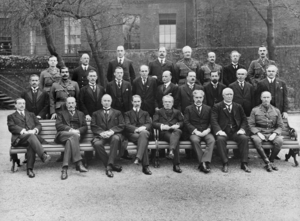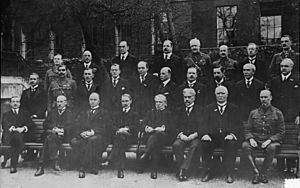Imperial War Cabinet facts for kids
The Imperial War Cabinet (IWC) was a special group formed during World War I. It brought together leaders from across the British Empire to make important decisions about the war. This included representatives from countries like Canada, Australia, India, New Zealand, South Africa, Newfoundland, and the United Kingdom.
The Cabinet met three times:
- First session: March to May 1917
- Second session: June to July 1918
- Third session: November 1918 to January 1919
These meetings helped the different parts of the British Empire work together. They also made the Dominions (self-governing countries within the Empire) feel more equal to Great Britain.
Contents
Why the Cabinet Was Formed
Working Together Across the Empire
For many years, the British Empire held meetings called Colonial Conferences. These started in 1887. Their goal was to bring the colonies and the United Kingdom closer. Leaders from self-governing colonies attended these meetings. However, India was not always represented.
More conferences took place in 1894, 1897, 1902, 1907, and 1911. When World War I began, the British Empire was not fully ready for a big land war. Its army was quite small.
A New Leader and a New Idea
David Lloyd George became the Prime Minister of the United Kingdom in December 1916. He wanted to improve how the Empire managed the war. He believed that the important Dominions and India should have the same status as Britain. This way, they could all discuss war plans together. This idea also aimed to strengthen the unity of the Empire.
Important Meetings
Calling All Leaders
In December 1916, Lloyd George sent a message to all parts of the British Empire. He invited their Prime Ministers to join the new War Cabinet. He said, "Your Prime Minister will be a member of the War Cabinet."
Leaders like Jan Smuts from South Africa and Robert Borden from Canada arrived in London. By March 20, 1917, most of the leaders were there. The first meeting of the Imperial War Cabinet then took place. Lloyd George felt this was a new beginning for the Empire. A newspaper called The Times wrote that this new cabinet would handle war decisions for the entire Empire. This included foreign policy, supplying troops, and war money.
Working as Equals
Even though the British Prime Minister led the meetings, the countries involved were mostly treated as equals. Between March and May 1917, the Cabinet held 14 meetings. The Prime Ministers also attended other meetings called the Imperial War Conferences. The discussions in the Cabinet were kept secret. However, it is believed they spent a lot of time discussing how to get more troops for the war.
Later Sessions
The Imperial War Cabinet met again in June 1918. Many current and former Prime Ministers gathered. They made important decisions. For example, they asked Canada to send troops to Siberia. The Cabinet also decided that Dominion Prime Ministers could talk directly with the British Prime Minister. After about six weeks, this session ended in July 1918. A minister from each Dominion stayed in London to represent their country.
The Cabinet was called together again in October 1918 to discuss peace after the war. The third session began in November. They talked about the terms of the Armistice of 11 November 1918, which ended the fighting. They also met with important leaders like Marshal Foch and Georges Clemenceau. In January 1919, the Cabinet's work moved to France. It became part of the British Empire delegation for the peace talks.
Who Was There?
This table shows some of the important people who were part of the Imperial War Cabinet:
| Nation | Name | Role |
|---|---|---|
| David Lloyd George | Prime Minister | |
| Lord Curzon | Leader of the House of Lords | |
| Bonar Law | Chancellor of the Exchequer | |
| Walter Long | Secretary of State for the Colonies | |
| Robert Borden | Prime Minister of Canada | |
| John Douglas Hazen | Minister of Fisheries | |
| Arthur Meighen | Minister of the Interior | |
| Jan Smuts | Minister of Defence | |
| Henry Burton | Minister of Railways | |
| Billy Hughes | Prime Minister of Australia | |
| Joseph Cook | Minister of the Navy | |
| William Massey | Prime Minister of New Zealand | |
| Joseph Ward | Deputy Prime Minister of New Zealand | |
| Edward Morris | Prime Minister of Newfoundland | |
| William F. Lloyd | Prime Minister of Newfoundland | |
| Austen Chamberlain | Secretary of State for India | |
| Ganga Singh | Maharaja of Bikaner | |
| Satyendra Prasanna Sinha | Member of the Executive Council of Bengal |
See also
- Committee of Imperial Defence
- Commonwealth Heads of Government Meeting
- Lloyd George ministry



